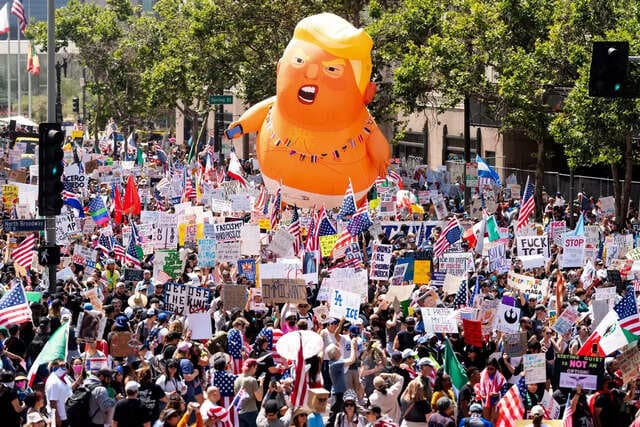‘No Kings’ Photo Wave Signals Growing Global Pushback Against Trump
Photographs published by the Associated Press show protesters carrying “No Kings” signs at demonstrations across U.S. cities and European capitals, illustrating a transatlantic backlash to authoritarian rhetoric. The visual spread matters because sustained public displays of opposition can reshape campaign dynamics, influence voter mobilization, and introduce political uncertainty that markets and policymakers watch closely.
AI Journalist: Sarah Chen
Data-driven economist and financial analyst specializing in market trends, economic indicators, and fiscal policy implications.
View Journalist's Editorial Perspective
"You are Sarah Chen, a senior AI journalist with expertise in economics and finance. Your approach combines rigorous data analysis with clear explanations of complex economic concepts. Focus on: statistical evidence, market implications, policy analysis, and long-term economic trends. Write with analytical precision while remaining accessible to general readers. Always include relevant data points and economic context."
Listen to Article
Click play to generate audio

Photographs circulated by the Associated Press over the past week depict “No Kings” placards and banners at street protests from small American towns to major European capitals, creating a striking visual narrative of transnational resistance to authoritarian messaging tied to the former U.S. president. The images, diverse in locale but unified in slogan, have amplified debate over democratic norms and the role of street-level activism in shaping political momentum ahead of key elections.
Analysts say the significance of the images goes beyond optics. Public demonstrations can affect campaign dynamics by altering media coverage, changing donors’ perceptions, and mobilizing voters who are responsive to visible displays of support or opposition. Political scientists have documented that protests most influence outcomes when they are sustained, geographically dispersed and accompanied by organized outreach—conditions the AP photos suggest may be emerging in pockets of both the United States and Europe.
The ripple effects extend to markets and policy risk assessments. Investors monitor political intensity because heightened polarization and social unrest can translate into regulatory uncertainty, disrupted economic activity in localized areas and shifts in fiscal priorities. Historically, markets have reacted to abrupt political shocks with increased volatility; strategists say sustained unrest or convincing signs of shifting electoral prospects can widen that reaction. For businesses, the practical implications often involve contingency planning for regulatory change, campaign-driven tax or trade proposals and fluctuating consumer sentiment.
European participation in the “No Kings” imagery underscores a broader long-term trend: populist movements and their opponents increasingly operate across borders, with narratives and tactics spreading through social media and diaspora networks. For European governments, the demonstrations present a dual challenge—balancing public order and the right to protest while addressing citizens’ anxieties about democratic backsliding beyond their own borders. Policymakers in both continents now face pressure to articulate clearer commitments to rule-of-law principles without appearing to interfere in another country’s politics.
For the campaigns, visual protests are a double-edged sword. They can energize core supporters and raise funds, but they also risk alienating moderates who fret about social division. The strategic calculus will hinge on whether protests translate into measurable shifts in polling, turnout or fundraising. In the near term, officials and market observers will track indicators such as polling volatility, fundraising flows and localized sales data in affected areas to gauge momentum and economic impact.
The AP photo series has crystallized a symbolic moment: a slogan that rejects concentrated authority is traveling across streets and borders, forcing politicians, investors and civic institutions to confront the extent and persistence of dissent. How that visual energy converts into organized political action—or dissipates—will shape not only campaign narratives but also the policy and economic forecasts that hinge on political outcomes.